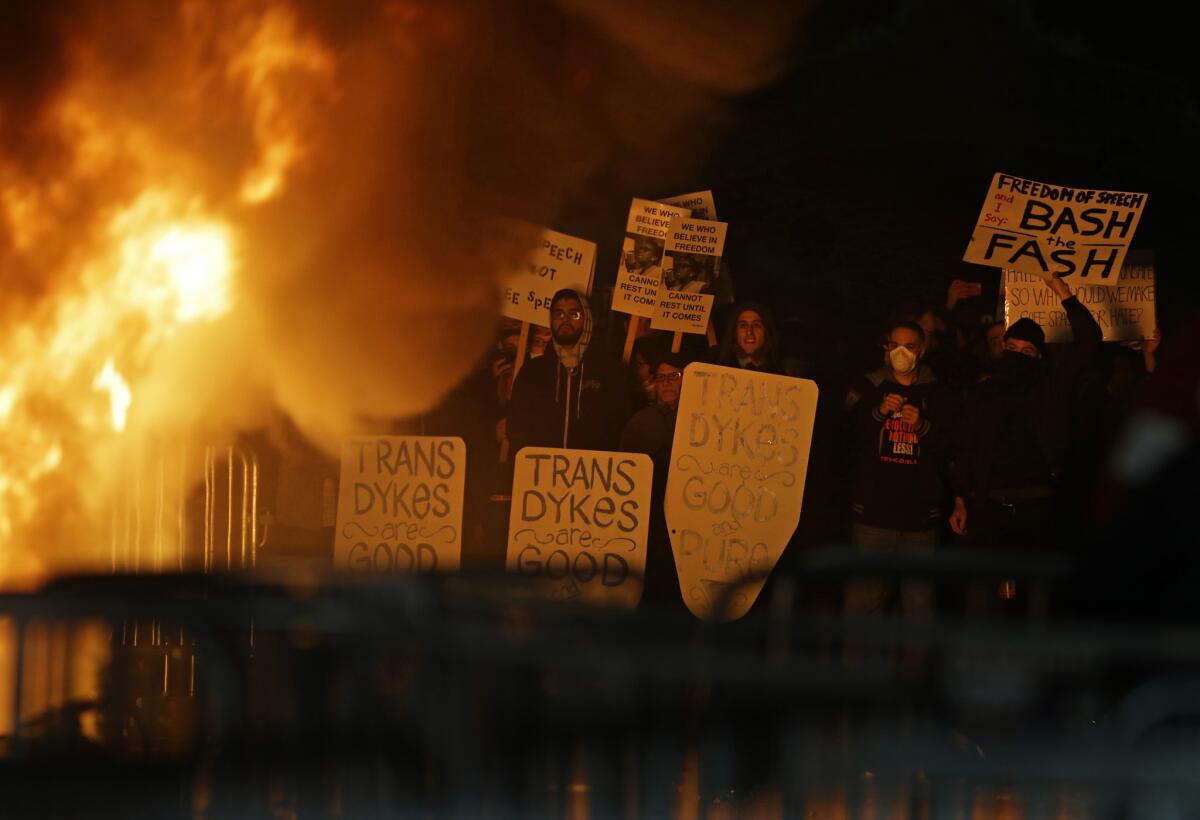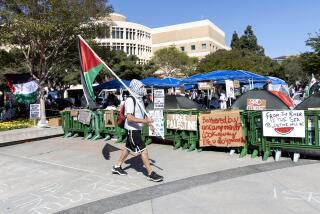UC Berkeley blames violent ‘black bloc’ protesters for ‘unprecedented invasion’

Protesters watch a fire on Sproul Plaza during a rally against the scheduled appearance by Breitbart News editor Milo Yiannopoulos at UC Berkeley.
- Share via
Reporting from BERKELEY — They dressed “like ninjas” and marched onto UC Berkeley’s Sproul Plaza like a paramilitary force armed with bats, steel rods, fireworks and Molotov cocktails, officials say.
The scheduled appearance Wednesday of conservative provocateur Milo Yiannopoulos was still two hours away, but it was precisely the time that most local television stations were beginning their live 6 p.m. broadcasts.
Within minutes, the group of 100 to 150 agitators had smashed half a dozen windows with barricades, launched fireworks at police and toppled a diesel-powered klieg light, which caused it to burst into flames.
“They didn’t come to lock arms and sing ‘Kumbaya,’” said Dan Mogulof, assistant vice chancellor and spokesman for the UC Berkeley. “They came to [mess stuff] up,” he said, using stronger language.
While so-called black bloc agitators have become a fixture of Bay Area demonstrations in the last decade, their appearance at Berkeley on Wednesday and otherwise peaceful demonstrations threatens to inflame tensions in an already polarized nation.
After learning that Yiannopoulos talk was canceled, President Trump tweeted: “If U.C. Berkeley does not allow free speech and practices violence on innocent people with a different point of view — NO FEDERAL FUNDS?”
The self-described anarchists or antifascists have left school and law enforcement agencies struggling to cope with their tactics.
Moving officers into Wednesday night’s melee, would have created “a lethal, horror situation,” said campus Police Chief Margo Bennett.
“We have to do exactly what we did last night: to show tremendous restraint,” she said.
UC Berkeley officials are now talking with federal and local law enforcement agencies about how to address black bloc tactics, which first appeared in Europe in the 1980s but have grown increasingly common in the United States in recent years.
To be sure, the University of California system has seen far larger disruptions by ordinary students. Window breaking and barricade tossing were common during Regents meetings when tuition was being raised significantly in the last decade, and protesters at UCLA trapped the Regents and other UC officials in a meeting building and garage.
But even though there was only one arrest Wednesday night, Berkeley officials insist the incident was something altogether new.
“We have never seen this on the Berkeley campus,” Mogulof said. “This was an unprecedented invasion.”
Mogulof said Berkeley administrators are dedicated to protecting the 1st Amendment and free speech, but certain events might need to have a closer look, especially if there is potential for major disruption and destruction on campus. School officials, he said, are reviewing their policing tactics as well as their policies and protocols for future events featuring controversial speakers.
He said “it’s not about limiting free speech,” but about protecting the students and campus.
The agitators, who keep their faces covered with bandannas, attach themselves to peaceful protests and then break out and start shattering windows and attacking cars, authorities say.
Police are investigating the group’s tactics, and additional arrests could come in the future, officials said.
Members of the group seem to be most active in Oakland, which has long been a hotbed of the protest movement. In downtown Oakland, shopkeepers have taken to boarding up their windows before protests they believe will attract the anarchist element.
At UC Berkeley, Police Chief Bennett said she doubts it would come to that on campus, but did allow there might need to be some rethinking about allowing controversial appearances to take place at night.
Twitter: VeronicaRochaLA
UPDATES:
10:20 a.m.: This article has been updated with information about Oakland demonstrations.
This article was originally published at 9:30 a.m.
More to Read
Sign up for Essential California
The most important California stories and recommendations in your inbox every morning.
You may occasionally receive promotional content from the Los Angeles Times.











